
|   |

|   |
e-mail: khokar1960@gmail.com Ideate, Instill, Inspire Lucknow photos: Kedar Jain October 28, 2016 AA: Not the Automobile Association or Alcoholics Anonymous but Annette & Anuj. Both from as vast spaces as Paris and Pari-war (family feud) Lucknow; Kathakali and Kathak. By now my comment in my many columns long ago has gone viral. The comment was that one Indian dance writer - a clueless dance writer/ from foreign service, hence almost a foreigner! (most live outside India half their lives, so can be clueless about Indian culture) - who had 3 columns going around on dance in Delhi, 3 decades ago asked me, “When did Ali get added to Kathak? (to become Kathakali?)” has gone viral and in every seminar and city I speak in now, with my films on dance history and heritage, someone in the audience pops up this question seeking identity of this great late writer. I say let dead remain dead. No ghost writing here! Annette Leday is as French as they come and she came to India in mid 70s to learn dance. She started with my mother guru M.K. Saroja (who had been to Paris many times before 1976, thanks to her mentor Ram Gopal, so was well known there those days) but soon she switched to Kathakali. Either she liked Kerala more or she felt in Kathakali, especially as stree vesham, one did not have to bend so much! 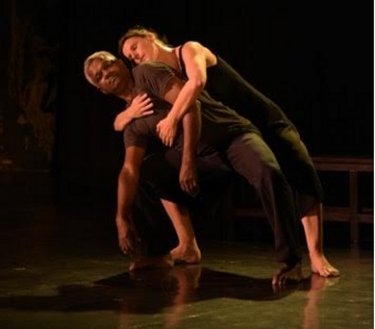
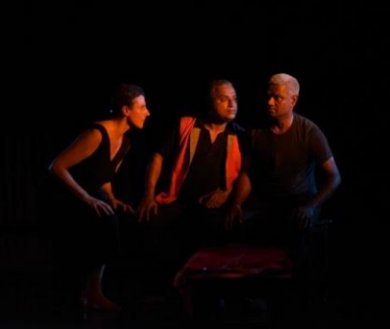
Annette Leday's group
Her over 40 years journey culminated in creating works in KK (Kathakali
for short) like King Lear, Cinderella and now, Mithuna. Performing all
over India, courtesy the Alliance Francaise, Annette has put all her
efforts into making KK international. Her use of KK is carefully minimal
because she feels this form is so dramatic that taken out of its
moorings (and aharya) it can look like Kabuki without being Japanese.
Meaning that such ancient forms are intrinsic to character of the form,
by taking it forward one must be sensible not to innovate at cost of
tradition. Only the French can think so deep and so long! In her
show at Kalakshetra, Chennai, the first row comprised of all who
mattered to her (as she announced) - her teacher Janardhanan Sir;
playwrights Mahesh Enkleshwar, Gowri Ramnarayan; the Dhananjayans her
second BN gurus and yours truly who she said, had followed her work for
as long as she had (40 years!). She performed to a half empty
Kalakshetra hall. One reason could be Vijayadasami holidays but the
management of Kalakshetra should have asked faculty and students to
attend. Annette's team of 3 dancers on stage made a deep impact.
When asked, the process of this work, Annette the philosopher, shared:Pics: Nivedan Mangalesh “It is indeed perhaps a bit difficult. Because it is very simple and simply asks the audience to just experience and share. There is nothing to « understand ». For me it is like a poem. You may not understand the logic of the words but if you allow yourself, you just perhaps can let go of the logics, sit back and just try to feel and experience what is going on. And what is going on is the magic and mystery of different beings and bodies who dialogue without words, whose understanding just flows between them and creates another level of meaning. And this rests on a very precise and demanding construction of space choreography and minute execution of movements, expressions and travels and contacts between dancers who have known each other for many years, trust each other and allow themselves to be mature and to be simply what they are. In addition I have explored different moments and energies which to me in a way convey the complex and sometimes rough realities of today's world. It goes through joy, love, violence and peace. The artistes in Mithuna are Hélène Courvoisier, a French professional dancer trained in ballet as well as in contemporary dance, Kalamandalam Unnikrishnan and Sadanam Manikandan who are both professional Kathakali performers and teachers who have trained in the best institutions of Kerala. The two Kathakali dancers engaged in my creative work parallel to their carrier as Kathakali artists right from my first Kathakali-King Lear production in 1989. Hélène joined us in 1997 for Cinderella Otherwise. The three of them have faithfully taken part in all my works since then, continuing their own career at the same time. The key elements of the work rely on presence, dance and movements. It focuses mainly on duos, but not only, and gives space for silence, for looking at each other, and for the individual talent of the performers. The work also deals with gender issues and brings the dancers to explore different types of energy. There is no narrative as such and each viewer is free to project his/her own story line if needed. The structure of the choreography rests on a poetic evocation of the complex forces at work between human beings in our world today.” For long, one has wondered what innovation in a dance drama form like KK can be. How can one maintain the structure and form without breaking or braking it? Annette answers that with her productions. King Lear was premiered at The Shakespeare Globe theatre, no less. Told you, the French were serious about what they do! Anuj Mishra on the other hand doesn't plan, doesn't think, just does! Here is a true artiste, totally unfoccussed, totally unaware of world and its mannerisms but once he gets on stage, his world begins and how! He is today the top male solo dancer of India, every month traversing the globe from Spain to a train in Argentina. He has over 100 students, who did shradhanjali on the first punyatithi anniversary of his late father and guru Pt. Arjun Mishra. Students from Srilanka and Switzerland, Bombay and Bangalore came to participate. Also came two iconic pillars of Lucknow Kathak - the guru of gurus and senior most Kathak talent of India today Pt. Birju Maharaj, the genius choreographer Kumudini Lakhia. We were all honoured on the occasion with white shawls and plaques but what was more important was Anuj managing the whole 2 day event with absolutely no corporate or local support (in UP there IS no govt ! Ulta Pradesh indeed. It was busy fighting internally, as we know). Only a handful of well-meaning citizens of Lukcnow, the Tiwaris PNB, The Tandons and the Tathastus! As to content, Anuj was again totally disorganized! Everyone wanted to pay homage to their guru so he let everyone do it, no matter what shape, size and structure. Manisha Mishra, daughter of famed tabla maestro Pt. Ravinath Mishra who accompanied her, impressed with her taut tayari (foundation) and first-rate delightful delivery and took us to Benaras aharya, rose in hair and all! Her psychedelic eyelids distracted from her beauty of form. Others who made a mark were of course Anuj with his sisters and one boy, Niraj. Neha shows growth as a dancer though she tries to over extend. Ankita, a grand niece of Shambhu Maharaj showed how dance was in their genes: in thaat itself one could see. Surabhi Tandon took extra long time to tell the tale of Rama appeasing the Devi and she looked better off stage in red sari the next day than with her weird dhoti with leotards costume topped with an Orissi belt when on stage depicting Kathak! Her hastas and facial expressions are enough, all else was extra. Like ten times going backstage scarf changing and using same limited stances. Was she dancing or doing drama? Due to her extra everything, the next dancer, senior most dancer Pt.Ram Mohan (a son of great Shambhu Maharaj) suffered time shortage. 
Banner at Lucknow airport
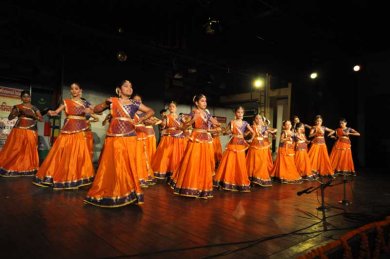 Students of Anuj Mishra 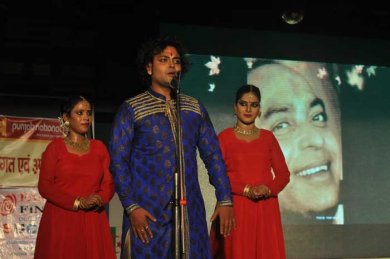 Anuj Mishra with his sisters Smriti & Kantika 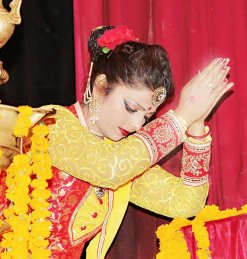 Manisha Mishra Two Srilankan sisters looked like they were from the 1960s, so quaint and old fashioned on stage. Two Bengali talents from Delhi, Pradipto Mukherjee and Ipsita Chatterjee were full of bling. Their dance had zing, although the male dancer looked like he was shooting arrows on stage! Which is why when Sanjukta Sinha came in her plain coarse looking offwhite khadi costume, she was a relief, even if her face was full of attitude! Her aesthetics and élan showed the distinct Kumiben stamp, even if she remains a senior student of late Pt. Arjun Mishra. Her dance had style and substance. Most other dancers had no business to bore audiences to death, especially when well past ten pm some were still carrying on while 80 years old pillars and citizens looked sleepy eyed. Anuj is sweet, well-meaning, uncomplicated, wonder boy of Kathak. It amazes one that he has travelled worldwide but still remains casual and cavalier about stage and schedules, costumes and constructs of time. Despite his organisational lacunas, Anuj needs all the support because he, after his father, is maintaining Kathak in Lucknow. He is the reason why so many are learning and dancing Kathak in Lucknow today. All others seniors had left Lucknow. Father and son helped reinstate Kathak in Lucknow in a big way and for that alone they deserve kudos and land and monies and awards! His team of excellent musicians, especially on the tabla the excellent Vikas Mishra, his cousin and singer Hriday Desai made both the evenings meaningful. 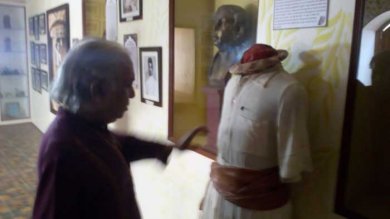 Birju Maharaj at the museum 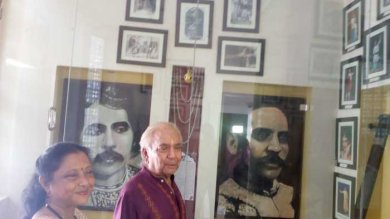 Saswati Sen & Birju Maharaj at the museum 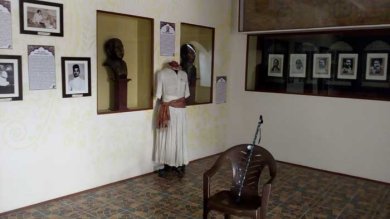
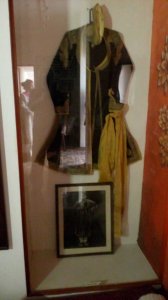
Museum
Jumping about cities and towns, I'm amazed what started as a Passion Project some 30 years ago when I was a Director of INTACH, has finally borne fruit. Birju Maharaj's ancestral home in Lucknow is being made a Kathak Museum! I used to catch the Gomti Express those days, as there was no shatabdi, and reach Lucknow from Delhi. The museum was inaugurated on Feb 6 by Akhilesh Yadav, the CM now fighting for survival. Maharaj-ji takes me on a special tour of each room and hall pointing each object, photos, costumes and memory associated with it. What a treat. I'm happy another dance museum has come up in another city, I wish each city has one! Like Mao said: Let a 1000 flowers bloom. For such museums coming up, lots of original, archival materials are needed. Not mere photos but press clips, brochures, posters. Originals. To help contextualize the form and artistes. Where to get that from? Only one source: Mohan Khokar Dance Collection. We have happily also donated archival materials, articles and memorabilia to this museum, as we did for Guru Gopinath museum in Trivandrum. And more coming up in Bangalore, Odisha and Madras. In Delhi, at AP Bhawan, the indefatigable Tadeppali (full of fat gold rings in each finger!) organized a 3 day focus on Kuchipudi with many good dancers participating. On the opening day, I sat with long lost Kuchipudi friend Pasumarthy Vithal, who was praising Mohan Khokar for connecting him to Indrani Rahman who took him on several tours abroad and today he has built a house in Gurgaon, oops Gurugram, a suburb of Delhi. I asked him why Kuchiupdi dancers lip sync all the time when few can do vaachika abhinaya and he said it is an affliction from past. We watched a fine male soloist Pasumarthy Mrutyunjaya Sarma, who was excellently tuned. Raja Reddy arrived in style looking like a true raja, but minus his wig/toupee he has worn for years now, he looks like Shetty the don from Hindi films of 70s! 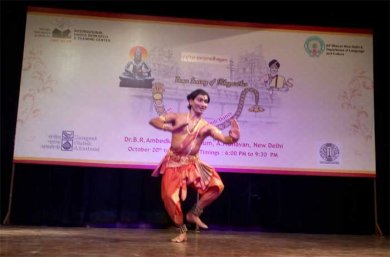 Mrutyunjaya Sarma 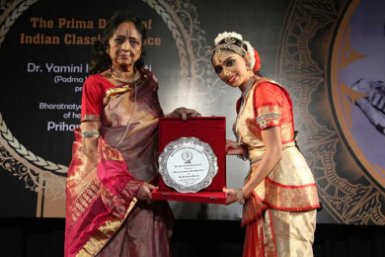 Yamini Krishnamurthy & Prihana Bhasin Earlier, at IIC, one saw iconic Yamini Krishnamurthy present the arangetram of her platinum student - 75th she meant! Prihana Bhasin, the platinum girl. Petite, pretty and puny too. Yamini's first student won her accolades and continues to - Rama Vaidyanathan. Her latest student Prihana shows the journey of an ageing diva. Geeta Chandran, the chief guest, commented: Prihana has potential. I'd add my two bit: if she maintains positions properly and articulates yatho hasta tahtho drishti. As a rule arangetrams are high pressure zones and the child is generally totally flustered preparing best foot forward. The Hindu made it a policy NOT to cover or review arangetrams (That's also because in Madras ten happen a day!). In each city, time permitting, I call on veterans who can't come to halls anymore. Meeting 93 year old Valmiki Banerjee at his home studio space in Chittaranjan Park, Delhi, took me back in time. The veteran of many shows in Delhi from before independence, this folk dance and choreography specialist has carried on Mission Impossible (of trying to instate Rabindra Natyam as a classical form) with help from dedicated students like Nancy Sahu now. Dada of dance, as we call him, still wishes to dance. That's the spirit! Way to go. Dance itself is trending! 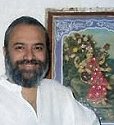 A
lover of history and dance, Ashish Khokar is author of more than 40
books, and is a columnist and critic for mainstream media like the Times
of India and India Today. He edits and publishes India's only yearbook
on dance ATTENDANCE (19th year) and teaches dance history and heritage
at many universities, worldwide. He curates and hosts many Dance
DISCourses and awards 5 annual awards. He is in charge of India's
largest archives, the Mohan Khokar Dance Collection. He lives in
Bangalore and Chennai. A
lover of history and dance, Ashish Khokar is author of more than 40
books, and is a columnist and critic for mainstream media like the Times
of India and India Today. He edits and publishes India's only yearbook
on dance ATTENDANCE (19th year) and teaches dance history and heritage
at many universities, worldwide. He curates and hosts many Dance
DISCourses and awards 5 annual awards. He is in charge of India's
largest archives, the Mohan Khokar Dance Collection. He lives in
Bangalore and Chennai.
Comments It is a piece of vivid word description of all that happened in alliterative and idiomatic language, coupled with brevity, and crispness. I felt as if I was seeing the productions sitting in each of the venues. - Tapati Chowdhurie (Oct 30, 2016) Post your comments Pl provide your name and email id along with your comment. All appropriate comments posted with name and email id in the blog will also be featured in the site. |